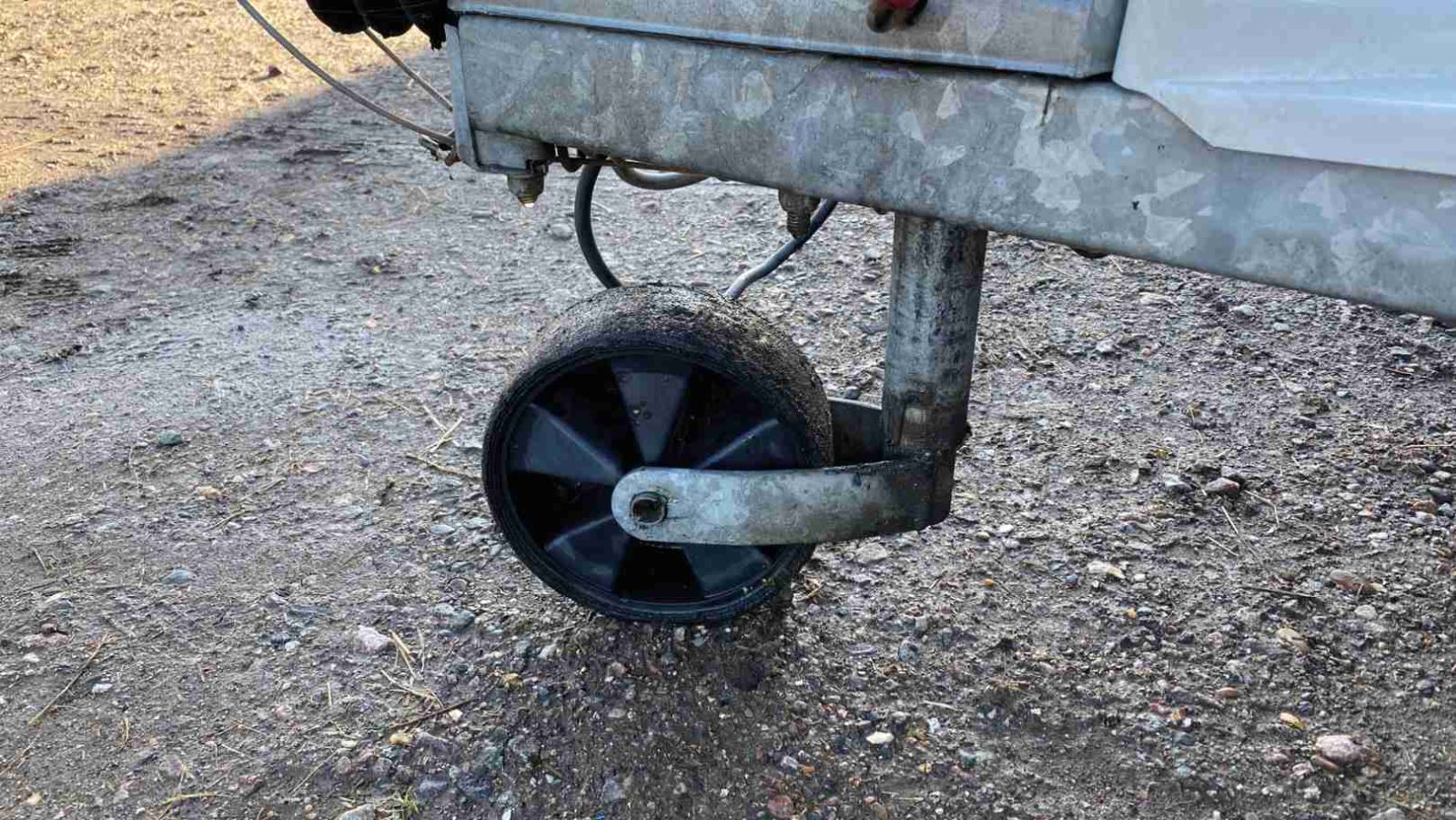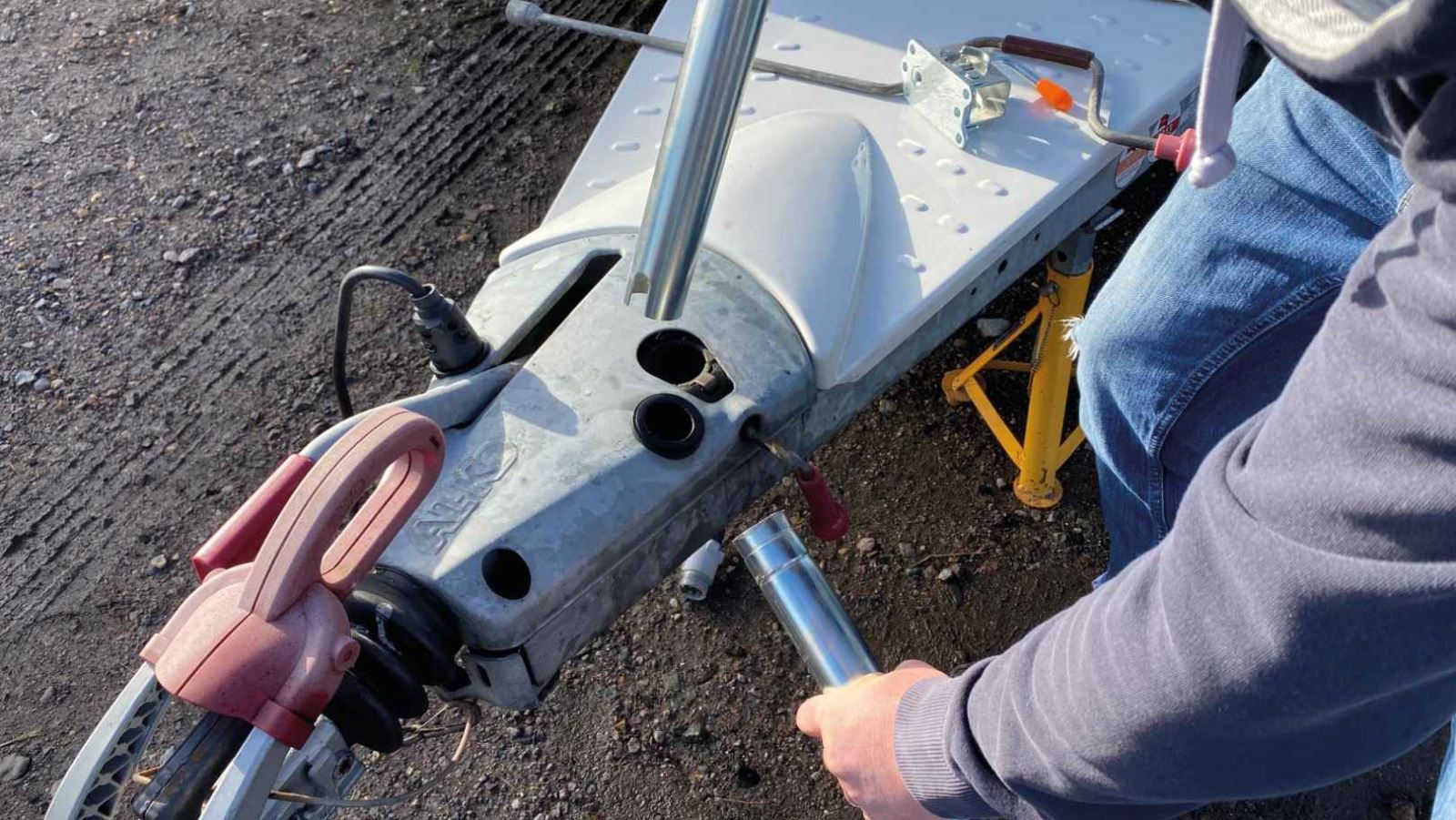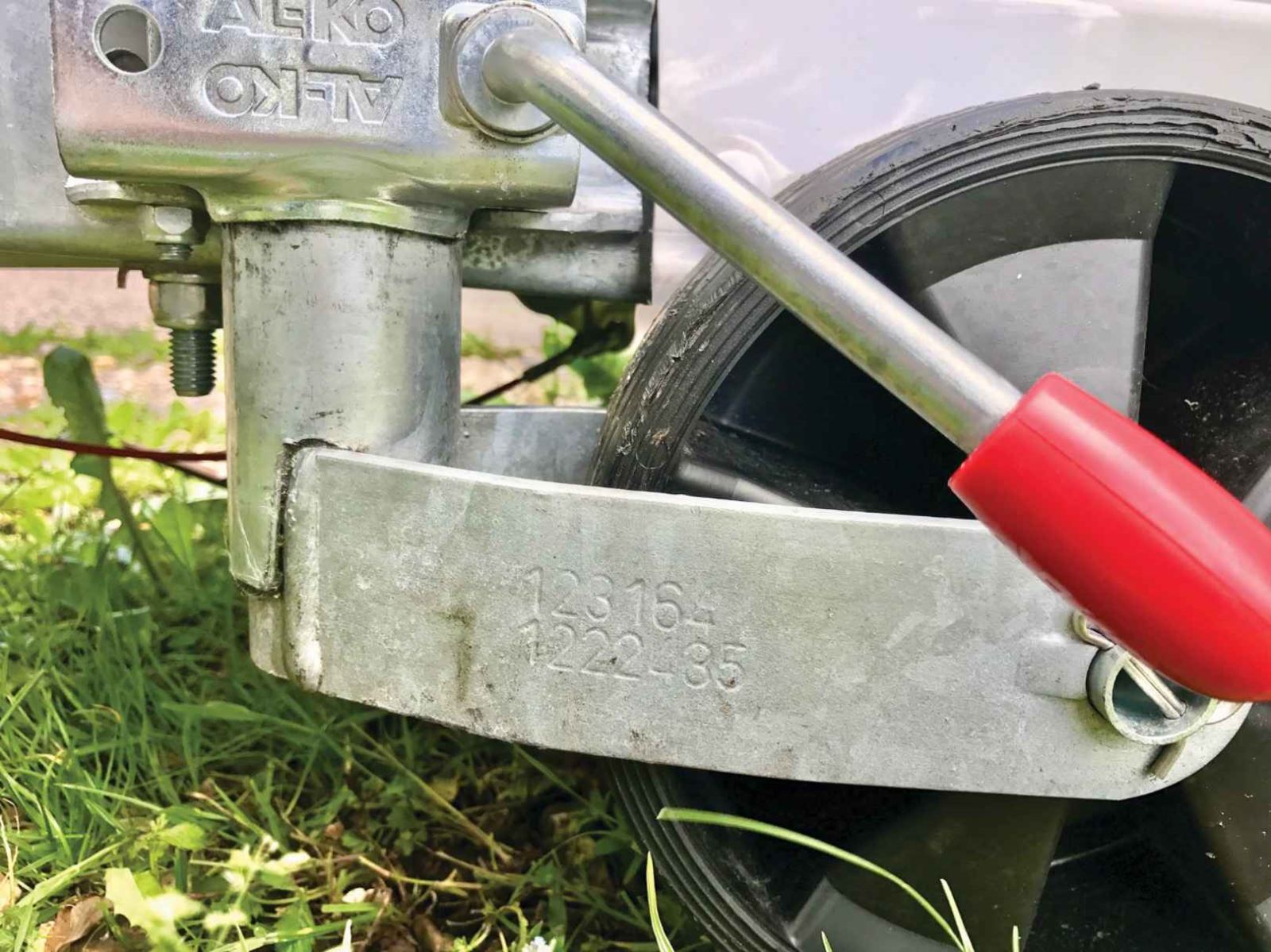Caravan jockey wheels: the definitive guide
A well-functioning caravan jockey wheel can make all the difference to manoeuvring away from the towcar, especially if you don't have a caravan mover to do the donkey work
With typical noseweights in the range of 75kg to 95kg, a jockey wheel has a lot of weight to carry. It stands to reason that the larger and wider a caravan jockey wheel is, the less likely it will be to sink on soft or loose surfaces.
A caravan jockey wheel that digs in can impose enormous strains on you, your caravan mover, your leisure battery and the jockey wheel's mounting bracket.
Page contents
Words by Louise Cottrill
What is a caravan jockey wheel?

(Photo courtesy of Jim Blackstock)
Simply put, a caravan jockey wheel is the wheel attached to the caravan A-frame that you use to help you pitch up the caravan. During transit, it is stored off the ground and you position it to help you steer the caravan once unhooked from the towcar.
It is a piece of equipment that takes an enormous strain. Even when pitched the jockey wheel helps take the noseweight strain, not leaving it all to the steadies.
How does a caravan jockey wheel work?
Here is how the jockey wheel functions:
Attachment: The jockey wheel is attached to a bracket on the A-frame of the caravan, near the hitch.
Wheel rotation: When you want to move or manoeuvre the caravan, you lower the jockey wheel until it makes contact with the ground. The swivelling wheel can then rotate freely.
Push or pull: With the jockey wheel in contact with the ground, you can easily push or pull the caravan into the desired position.
Height adjustment: If necessary, you can also adjust the height of the jockey wheel to level the caravan. This is particularly useful when parking on uneven ground.
Retraction: When you're ready to tow the caravan, you raise the jockey wheel until it's clear of the ground. It should be stowed securely to the A-frame, usually using a clamp or lock mechanism, to avoid any interference when you're driving.
What size wheel do I need for a caravan?
Generall, a standard 48mm-diameter jockey wheel is common for caravans and should work well for most applications. However, for heavier caravans or challenging terrain, you may want to consider a larger jockey wheel with a greater noseweight capacity.
It's essential to check your caravan's specifications and consult with the manufacturer or a caravan accessory retailer for guidance on selecting the appropriate jockey wheel size for your specific caravan.
How to measure a jockey wheel
Measure both the diameter of the wheel and the length of the shaft. You will then have the necessary dimensions to identify or select the right replacement jockey wheel or any jockey wheel accessories you may need.
Keep in mind that jockey wheels are available in various sizes, so having accurate measurements is crucial to ensure a proper fit and functionality for your caravan. Head to your local dealer if you are unsure.
How to fit a jockey wheel to a caravan

(Photo courtesy of Jim Blackstock)
Choose the right location: Before you start, determine where on the drawbar you want to attach the jockey wheel. It's typically towards the front but may vary based on your caravan's design.
Check the wheel height: Ensure the caravan is on a level surface, and the hitch is at the desired height for coupling to your towing vehicle.
Lubricate the jockey wheel: Apply lubricating oil or grease to the moving parts of the jockey wheel for smoother operation.
Attach the bracket: If your jockey wheel comes with a bracket, attach it to the desired location on the drawbar. Use the provided bolts and nuts to secure it. Make sure it's tight and secure.
Slide the jockey wheel into the bracket: If your jockey wheel has a shaft, insert it into the bracket. It may have a locking mechanism that clicks into place when properly inserted.
Secure the jockey wheel: Tighten any bolts, nuts, or clamps on the bracket to secure the jockey wheel in place. Ensure that the wheel is straight and level with the ground when in the down position.
Test the operation: Lower the jockey wheel to the ground using the winding mechanism (crank or handle). Ensure it's firmly supporting the caravan's weight and can be raised and lowered easily.
Stow the jockey wheel: When you're ready to tow your caravan, raise the jockey wheel to the fully stowed position. Make sure it's not hanging too low to the ground, which could cause damage when driving.
Secure the jockey wheel handle: Many jockey wheels have a handle that can be secured in the upright position to prevent it from swinging during travel.
Perform a final check: Before hitting the road, double-check that the jockey wheel is securely stowed and that all nuts and bolts are tightened.
With these steps, your jockey wheel should be securely and correctly fitted, making it easier to manoeuvre and park your caravan. All this aside, if you are not confident doing this yourself, it is always best to ask a professional to fit it for you.
Types of jockey wheels

(Photo courtesy of Jim Blackstock)
Standard jockey wheel: This is the most common type of jockey wheel. It consists of a single wheel mounted on a shaft with a winding handle. Standard jockey wheels are versatile and suitable for most caravans.
Swivel jockey wheel: These jockey wheels have a swivel mechanism that allows you to pivot the wheel for easy manoeuvrability. They are ideal for tight spaces and tight turns.
Pneumatic jockey wheel: Pneumatic jockey wheels have air-filled tyres, which provide better shock absorption and manoeuvrability, especially on rough or uneven terrain. They are suitable for larger and heavier caravans.
Serrated wheel jockey: Serrated wheels are designed for improved traction, making them suitable for use on soft or slippery surfaces, such as grass or wet ground.
Motorised jockey wheel movers: These are motorised systems that can be attached to the jockey wheel, allowing you to move your caravan with ease using a remote control. They are excellent for caravans with a high weight.
Screw-type jockey wheel: Screw-type jockey wheels have a screw mechanism instead of a winding handle. They are convenient for caravans with heavier loads and offer precise control when adjusting the height.
Jockey wheel with suspension: These jockey wheels have integrated suspension systems to absorb shocks and provide a smoother ride. They are suitable for caravans with fragile or sensitive cargo.
Ratchet jockey wheel: Ratchet jockey wheels use a ratcheting mechanism for effortless winding and unwinding. They are often preferred for caravans with heavy loads.
Final thoughts
In summary, a jockey wheel plays a vital role in ensuring the safe and efficient operation of a caravan. It assists with manoeuvrability, height adjustment, weight distribution, and the overall stability of the caravan during both towing and stationary periods.
Whatever you are doing with your jockey wheel, always ensure it is locked in tight and in good repair.
Expert Caravan advice to your door!

Caravan magazine has been inspiring caravanners for more than 80 years! We have grown to become a leading authority on caravans, the caravan industry, caravan lifestyle, campsites and caravan travel destinations. We know what our readers want – and that's to make the most of their caravans and their holidays!
Want to know more about Caravan magazine?
About Caravan magazine







Recent Updates
Caravan showers: all you need to know
In this guide, we’ll discuss the different types of showers, how they work, and how to fit an external shower point to your caravan ...
Caravan towing: all you need to know
Towing a caravan may seem daunting initially, but a few simple tips can make the journey enjoyable and ...
All you need to know about towbars & towballs
Flange, detachable, swan neck, retractable – towbar technology choice is bewildering. Don’t worry. We’ll ...
Caravan WiFi: everything you need to know
Caravan holidays are the ultimate way of getting away from it all, although we sometimes need a link to the ...
Caravan insurance: all you need to know
Navigating the world of caravan insurance can feel like a daunting task. Fear not, as this comprehensive ...
Buying a caravan: what you need to know
Let us guide you through some of the complicated things to think about when first looking at buying a ...
Caravan awnings: a buyers' guide
Caravan awnings are a fantastic addition to any caravan as they are one of the simplest, quickest and most ...
Caravan electrics: avoid tripping out
All caravan owners have overloaded their mains supply at some time. Here’s how to master caravan electrics ...
Caravan heating systems: a quick guide to caravanning warmth
When winter is here, you’ll be glad of a decent caravan heating system if you’re out touring. Here’s how the ...
Caravan damp: a complete guide
There's little more guaranteed to strike fear into the heart of a caravan owner than the word 'damp'. But if ...
Other Articles
Caravan cooking recipes
Caravan cookery inspirational ideas. No need to stress out in the kitchen with these quick and easy time-saving dishes ...
Caravan bike racks: a complete guide
Exploring the beautiful surroundings while on a caravan trip is undeniably one of the greatest joys of the ...
Caravan solar panels: all you need to know
Whether you dream of roaming off-grid or just fancy reducing your carbon footprint, fitting solar panels to ...
The ultimate guide to caravan layouts
Choosing the right layout or floorplan of your caravan is an all-important part of the buying process – find ...
A guide to seasonal caravan pitches
Our in-depth guide to finding and securing seasonal caravan pitches on your favourite campsite ...
Caravan weights and payloads: a quick guide
The terminology of caravan weight – MIRO, MTPLM, noseweight, kerbweight, payload, weight plate upgrade – is ...
The ultimate guide to caravan motor movers
Caravan motor movers: everything you need to know about remote control caravan manoeuvring ...
Caravan cleaning: All you need to know
Whether you’re taking the caravan out for the first time or it’s just in need of a spruce up, our guide will ...
18 essential items for camping with your dog
Camping is for the whole family – including our four-legged members. Here's what you'll need to keep your dog ...
14 welly boots for camping trips
It might be April but that won’t stop the rain in the UK, so a pair of comfortable welly boots is still ...